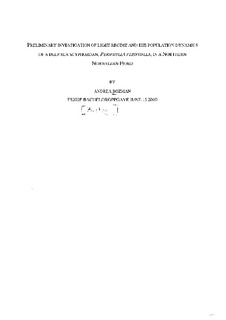| dc.contributor.author | Bozman, Andrea | |
| dc.date.accessioned | 2010-09-24T09:01:07Z | |
| dc.date.available | 2010-09-24T09:01:07Z | |
| dc.date.issued | 2010 | |
| dc.identifier.uri | http://hdl.handle.net/11250/141157 | |
| dc.description | Studentarbeid i biologi (bachelorgrad) - Høgskolen i Bodø, 2010 | en_US |
| dc.description.abstract | Jellyfish blooms have been reported worldwide and have ecological and economical
consequences. Causes of mass abundances have suggested and include eutrophication, climate
change and overfishing. The deep-sea medusa Periphylla periphylla has colonized fjords of
western Norway in mass numbers since the 1970s and more recently there have been reports of
high population numbers in fjords of northern locations. The species experiences fatalities when
exposed to light as the medusa pigment is photodegraded. The extended daylight hours of the
summer months in northern Norway may be a factor limiting the northern distribution of the P.
periphylla. Vefsnfjorden is the northemmost fjord with reported mass abundances. Samples were
collected from the fjord over a four month period from Febmary to May of201O specimens were
sorted by developmental stage. Here I present a decrease in both overall numbers of individuals
and age classes in Vefsnfjorden, which was most likely caused byaflushing event in the fjord.
The lack of early developmental stages collected in the later sampling trips sugge st the
Vefsnfjorden population may have seasonal reproduction rather than year round as is the case
with more southern populations. | en_US |
| dc.language.iso | eng | en_US |
| dc.publisher | Høgskolen i Bodø | en_US |
| dc.subject | biologi | en_US |
| dc.title | Preliminary investigation of light regime and the population dynamics of a deep sea scyphozoan, Periphylla periphylla, in a Northern Norwegian fjord | en_US |
| dc.type | Bachelor thesis | en_US |
| dc.subject.nsi | VDP::Agriculture and fishery disciplines: 900::Fisheries science: 920::Resource biology: 921 | en_US |
